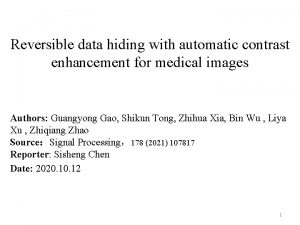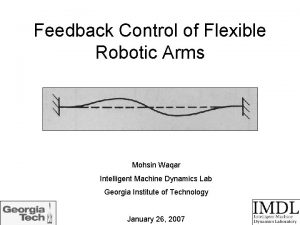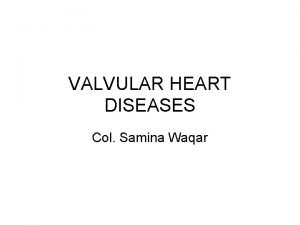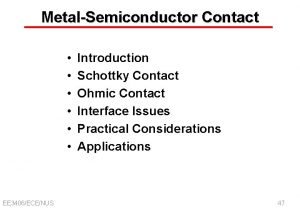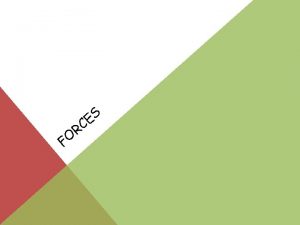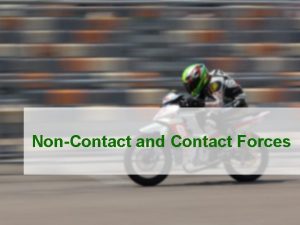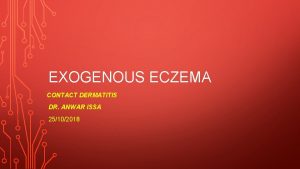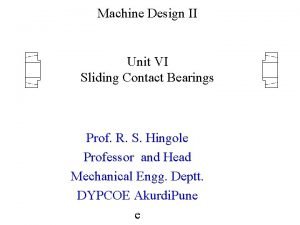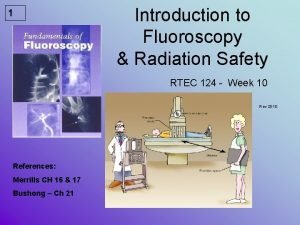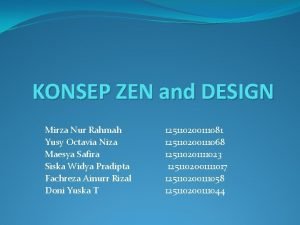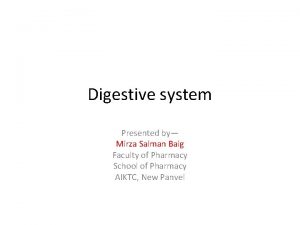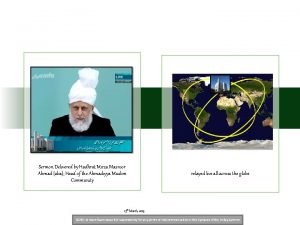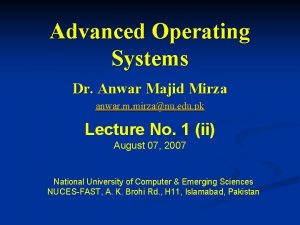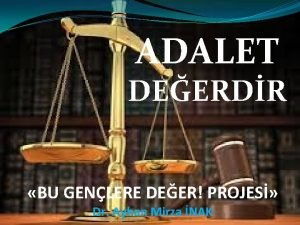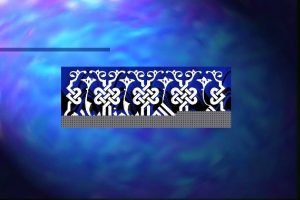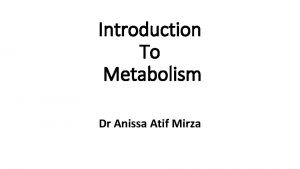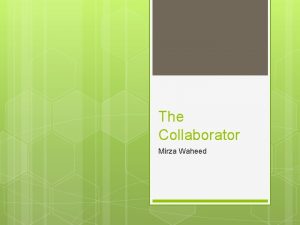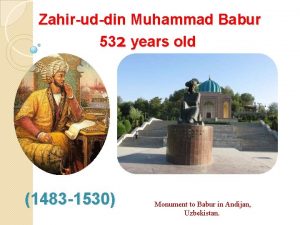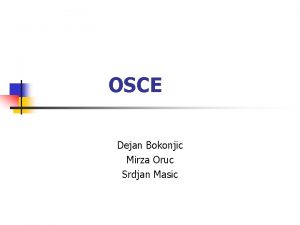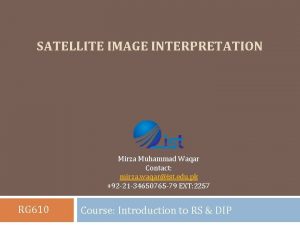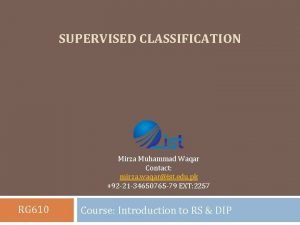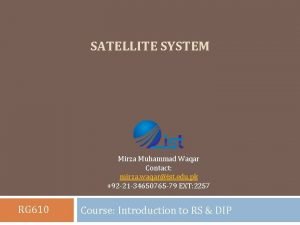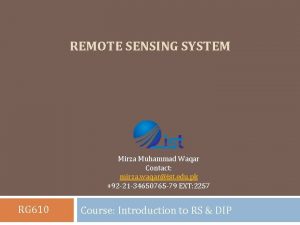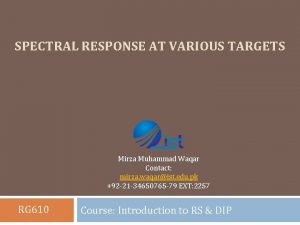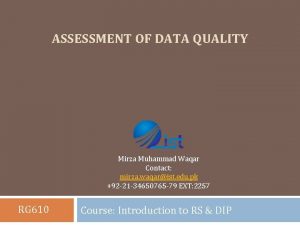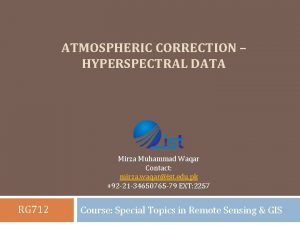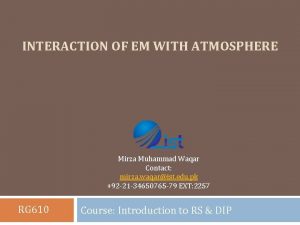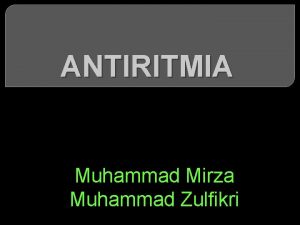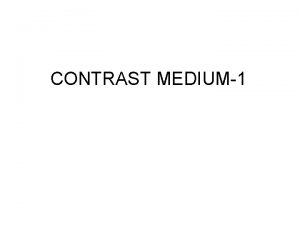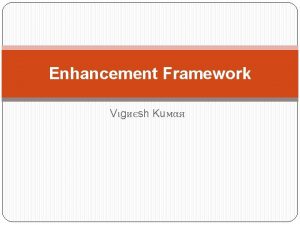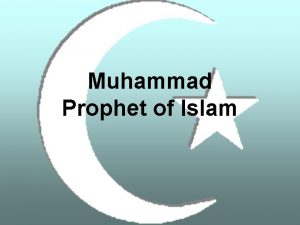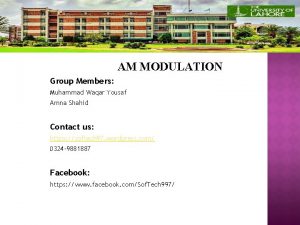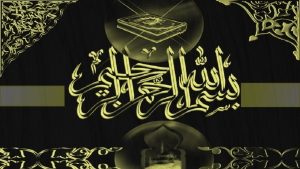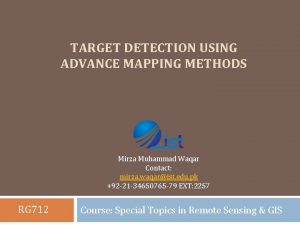SPECTRAL CONTRAST ENHANCEMENT Mirza Muhammad Waqar Contact mirza





























- Slides: 29

SPECTRAL CONTRAST ENHANCEMENT Mirza Muhammad Waqar Contact: mirza. waqar@ist. edu. pk +92 -21 -34650765 -79 EXT: 2257 RG 610 Course: Introduction to RS & DIP

Contents 2 Geographical Information System Remote Sensing & Satellite Image Processing Color Space Landsat 7 spectral bands Spectral Reflectance Curves Image Interpretation Spectral Ratioing Indices

Overview 3 One of the strength of image processing is that it gives us the ability � To enhance the view of an area by manipulating the pixels value. Contrast enhancement does not change the values in the image rather simply adjust the colors associated with these color values.

Image Enhancement The alteration of the appearance of an image in such a way that the info contained in that image is more readily interpreted visually in terms of a particular need It alters the visual impact of the image to improves the info contents for the interpreter These operations improve the interpretability of an image by changing the contrast between the features in the scene To improve the appearance of an image for human visual analysis

Image Enhancement No single standard method can be said to be the best, it depends upon the need of the user The characteristic of each image in terms of distribution of pixel values over 0 -255 range will change from one area to another , thus enhancement tech suited for one image may not be good for other image covering different type of area

Image Histogram greatly helps to deduce the appearance of an image � In a dark image, the gray levels would be clustered towards the lower end � In a uniformly bright image, the gray levels would be clustered towards the upper end � In a well contrasted image, the gray levels would be well spread out over much of the range

Image Enhancement Methods of improving visual interpretability of an image � By altering the contrast of an image ( contrast stretching) � Converting from black and white to color representation Contrast is simply the range and the distribution of the pixel values over the 0 -255 gray scale

Perception of Colors Conversion to color is desirable as the eye is more sensitive to variations in hue than change in the brightness

Contrast Enhancement/ Stretching Sensors record reflected or emitted radiant flux exiting from earth surface materials Ideally one material would reflect tremendous amount of energy in a certain wavelength while another much less in the same wavelength This would result in contrast between the two types of materials In some cases different materials would often reflect similar amount of radiant flux throughout the visible and IR portion of EM spectrum resulting in a relatively low contrast image

Contrast Enhancement Sensor on board have to be capable of detecting upwelling radiance levels ranging from low (from oceans) to very high (over snow) For particular area to be imaged , it is unlikely that full dynamic range of the sensor will be used , thus the corresponding image is dull or over bright-over or under exposed

Why we need Contrast Enhancement 11 Quite often the useful data in a digital image populate only a small portion of available range of digital values. � Commonly 8 bit or 256 levels Contrast enhancement involves changing the original values so that more of the available range is used. It increases the contrast among the features and their background.

Types of Contrast Enhancement 12 1. 2. 3. 4. 5. 6. 7. 8. 9. 10. 11. Histogram Equalization Stretch Standard Deviation Stretch Gaussian Stretch Gamma Correction Level Slice Constant Value Invert Stretch Percentage LUT Piecewise Linear Contrast Stretch Linear Stretch Logarithm Stretch

Linear Contrast Enhancement 13 This technique involves the translation of the image pixel values from the observed range of digital number to the full range of the display device (e. g. 8 bit)

LINEAR STRETCH-MIN MAX The uniform expansion of the of input digital numbers to full range )-255) is called linear stretch BV OUT=255(BV IN-MIN) / (MAX-MIN) MIN=25, MAX=225 130 165 100 135 145 134 179 96 140 153 57 35 25 50 65 41 13 0 32 51 180 215 135 200 205 205 220 225 30 25 25 120 205


Histogram Equalization Stretch 16 This stretch assign more display values (range) to the frequently occurring portion of the histogram. In this way, the detail in those areas will be better enhanced having high frequency relative to those areas having low frequency value in the histogram.

Histogram Conversion The histogram of the original image is converted to other types of histograms as specified by user � Histogram Stretch- Image values are assigned to the display levels on the basis of their frequency of occurrence � More display values ( more radiometric details) are assigned to the frequently occurring portion of histogram � Special Stretch- To analyze specific features in greater radiometric detail s by assigning the display range exclusively to a particular range of image values

Histogram Stretch

Histogram Equalization After Before

Standard Deviation Stretch 20 Standard deviation stretch trim all pixels that have a digital number beyond the range the defined standard deviation; � Then perform the linear stretch for the remaining pixels Standard Deviation 1: 67 % Standard Deviation 2: 95 % Standard Deviation 3: 99 %

Gaussian Stretch 21 This histogram involve the fitting of the observed histogram to normal or Gaussian histogram. This stretch adjust the range of lookup table values so that the output histogram is approximately a normal distribution.

Level Slice Stretch 22 It will slice the input image into user defined number of classes. The output image will have only limited number of variations depending upon the user defined number of classes.

Density/ Level Slicing Representation of a range of contiguous gray levels of gray scale image by a single color Used to separate the data into “n” intervals or “slices” based on the histogram from one wavelength band. All data within a slice are displayed as one digital number or color in the output image The Gray level in the output image corresponds to the number of slices Used frequently with thermal images, i. e. different temperature ranges can be shown with different slices

Level Slicing After Before

Invert Contrast Stretch 25 This contrast enhancement technique invert the current lookup table values. This has the effect of producing a photographic negative of the image. This technique is often used to extract information from the shadow.

Gray-Level Thresholding Used to “segment "an input image into two classes. Purpose is to develop a binary mask for one category, so that processing can be applied to each class independently Original NIR Image Set threshold here Mask Image for Water

Contrast Enhancement If the range of gray levels could be altered so as to fit the full range of the black and white axis, then the contrast between the dark and bright areas of the image would be improved Does not modify the original data unless new file is saved


Questions & Discussion
 Contrast enhancement
Contrast enhancement Dr mohsin waqar
Dr mohsin waqar Saiama
Saiama Dr waqar malik
Dr waqar malik Rheumatic heart disease
Rheumatic heart disease Attahiyat in roman english
Attahiyat in roman english Dua e sabah
Dua e sabah What is non contact force
What is non contact force Contact forces
Contact forces What is dangling bond
What is dangling bond Contact vs non contact forces
Contact vs non contact forces Air resistance contact force
Air resistance contact force Post encounter stage
Post encounter stage Non contact force examples
Non contact force examples Paranochyia
Paranochyia Disadvantages of sliding contact bearing
Disadvantages of sliding contact bearing Non contact force
Non contact force Double contrast vs single contrast
Double contrast vs single contrast Konsep zen
Konsep zen Dr mirza salman baig
Dr mirza salman baig Dr dan mirza
Dr dan mirza Dr mirza ahmad
Dr mirza ahmad Anwar majid mirza
Anwar majid mirza Ayhan mirza inak
Ayhan mirza inak Lynch howarth incision
Lynch howarth incision Ana mirza
Ana mirza Dr atif mirza
Dr atif mirza The collaborator mirza waheed
The collaborator mirza waheed Zahiruddin muhammad
Zahiruddin muhammad Mirza oruc
Mirza oruc
